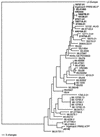Development of a heteroduplex mobility assay to identify field isolates of porcine reproductive and respiratory syndrome virus with nucleotide sequences closely related to those of modified live-attenuated vaccines
- PMID: 12791860
- PMCID: PMC156521
- DOI: 10.1128/JCM.41.6.2433-2439.2003
Development of a heteroduplex mobility assay to identify field isolates of porcine reproductive and respiratory syndrome virus with nucleotide sequences closely related to those of modified live-attenuated vaccines
Abstract
Porcine reproductive and respiratory syndrome has been devastating the swine industry since the late 1980s. The disease has been controlled, to some extent, through the use of modified live-attenuated (MLV) vaccines once available. However, such a practice periodically resulted in isolation or detection of vaccine-like viruses from pigs as determined by a partial genomic sequencing. In this study, we developed a heteroduplex mobility assay (HMA) for quickly identifying porcine reproductive and respiratory syndrome virus (PRRSV) isolates with significant nucleotide sequence identities (>/=98%) with the modified live-attenuated vaccines. The major envelope gene (ORF5) of 51 PRRSV field isolates recovered before and after the introduction of the vaccines was amplified, denatured, and reannealed with the HMA reference vaccine strains Ingelvac PRRS MLV and Ingelvac PRRS ATP, respectively. Nine of the 51 field isolates and the VR2332 parent virus of Ingelvac PRRS MLV, which were all highly related to Ingelvac PRRS MLV with </=2% nucleotide sequence divergence as determined by sequence analysis, were all identified by the HMA to form homoduplexes with the reference Ingelvac PRRS MLV. No homoduplex-forming field isolate was identified when Ingelvac PRRS ATP was used as the HMA reference except for its parent virus JA142. Other field isolates with more than 2% nucleotide sequence divergence with the respective reference vaccine strain resulted in the formation of heteroduplexes with reduced mobility in polyacrylamide gel electrophoresis. The HMA results also correlated well with the results of phylogenetic analyses. The data indicated that the HMA developed in the study may be a rapid and efficient method for large-scale screening of potential vaccine-like PRRSV field isolates for further genetic characterization.
Figures


References
-
- Allende, R., T. L. Lewis, Z. Lu, D. L. Rock, G. F. Kutish, A. Ali, A. R. Doster, and F. A. Osorio. 1999. North American and European porcine reproductive and respiratory syndrome viruses differ in non-structural protein coding regions. J. Gen. Virol. 80:307-315. - PubMed
-
- Bachmann, M. H., C. Mathiason-Dubard, G. H. Learn, A. G. Rodrigo, D. L. Sodora, P. Mazzetti, E. A. Hoover, and J. L. Mullins. 1997. Genetic diversity of feline immunodeficiency virus: dual infection, recombination, and distinct evolutionary rates among envelope sequence clades. J. Virol. 71:4241-4253. - PMC - PubMed
-
- Barlow, K. L., J. Green, and J. P. Clewley. 2000. Viral genome characterization by the heteroduplex mobility and heteroduplex tracking assays. Rev. Med. Virol. 10:321-335. - PubMed
-
- Botner, A., B. Strandbygaard, K. J. Sorensen, P. Have, K. G. Madsen, E. S. Madsen, and S. Alexandersen. 1997. Appearance of acute PRRS-like symptoms in sow herds after vaccination with a modified live PRRS vaccine. Vet. Rec. 141:497-499. - PubMed
Publication types
MeSH terms
Substances
Associated data
- Actions
- Actions
- Actions
- Actions
- Actions
- Actions
- Actions
- Actions
- Actions
- Actions
- Actions
- Actions
- Actions
- Actions
- Actions
- Actions
- Actions
- Actions
- Actions
- Actions
- Actions
- Actions
- Actions
- Actions
- Actions
- Actions
- Actions
- Actions
- Actions
- Actions
- Actions
- Actions
- Actions
- Actions
- Actions
- Actions
- Actions
- Actions
LinkOut - more resources
Full Text Sources
Other Literature Sources

